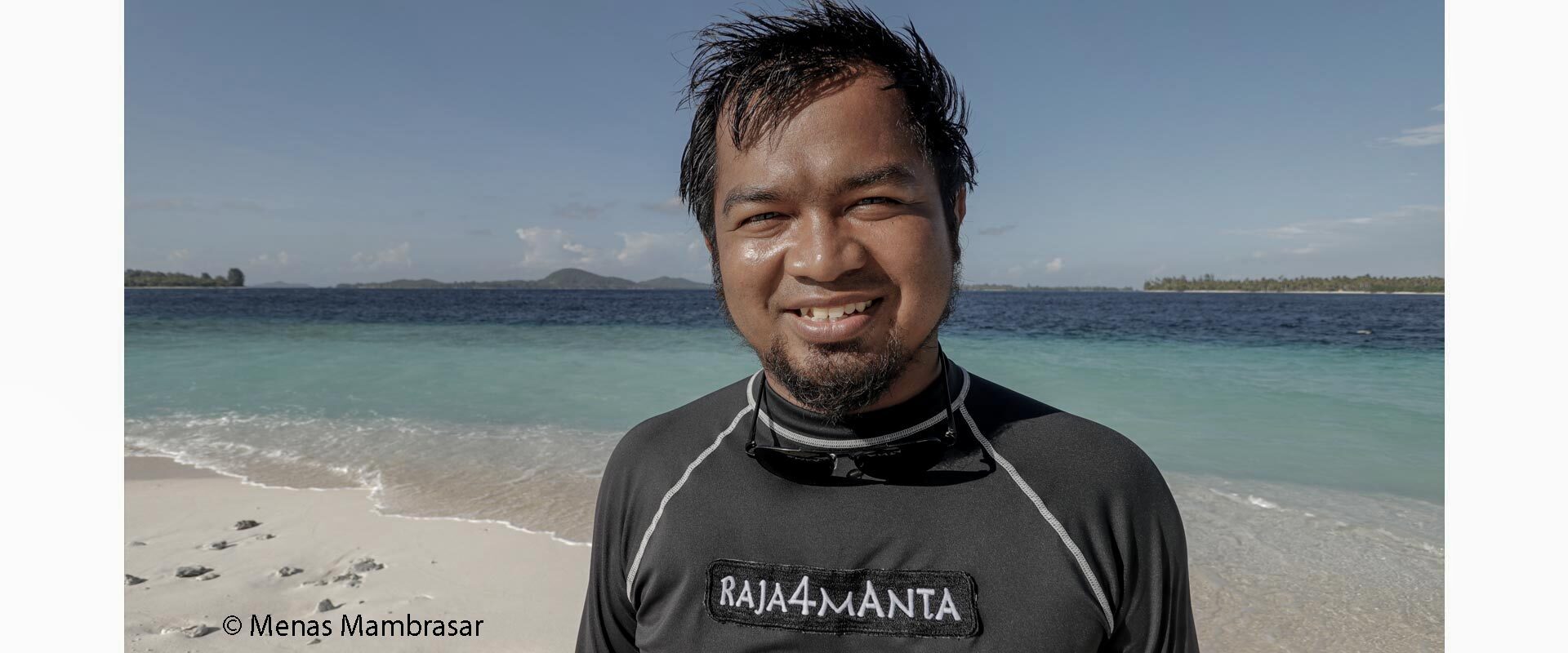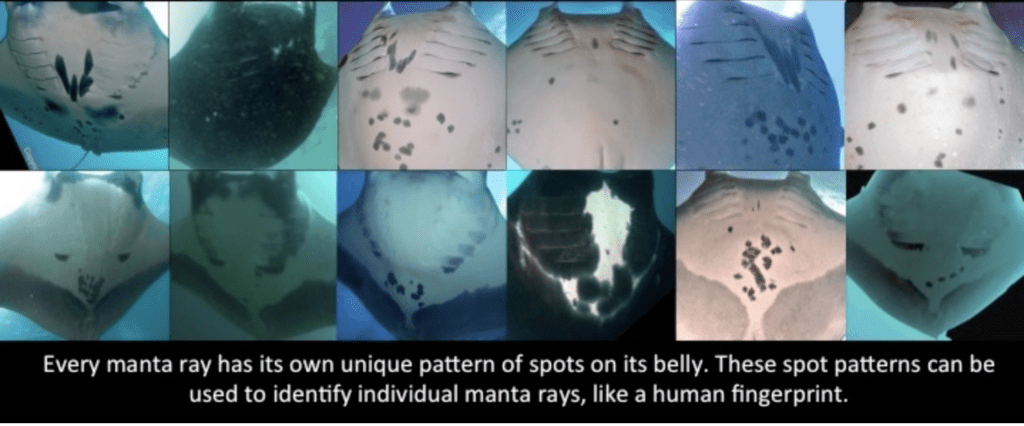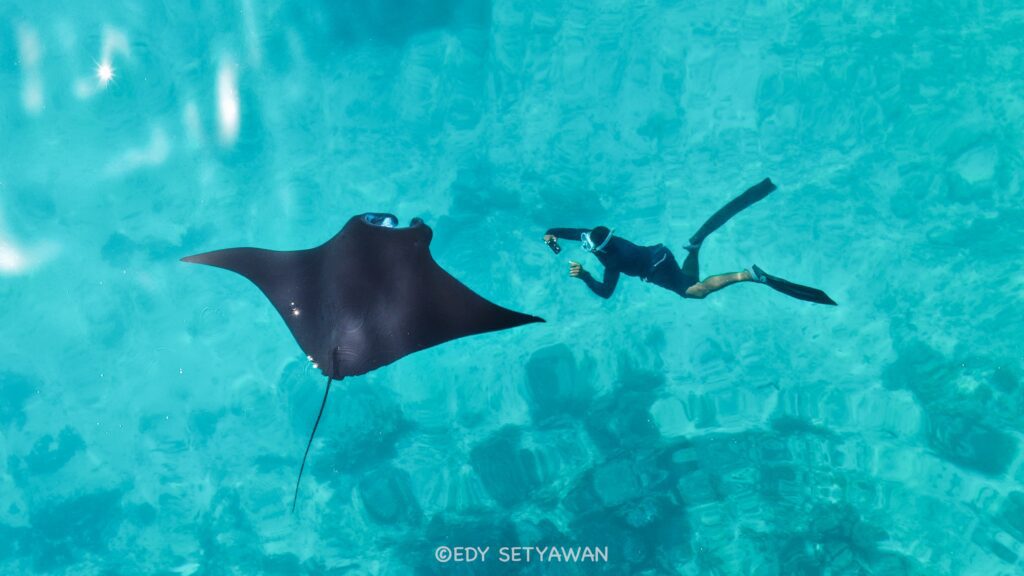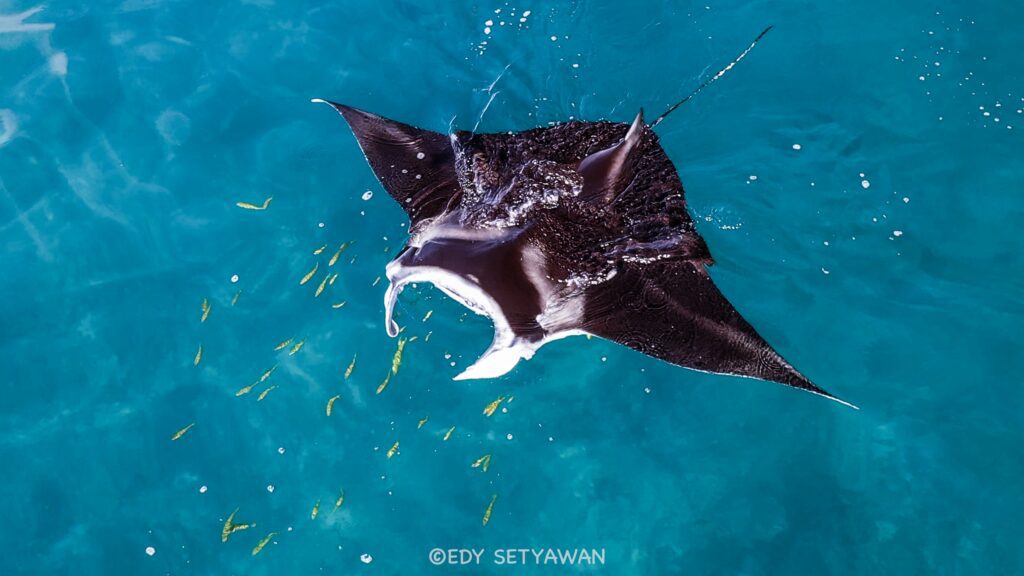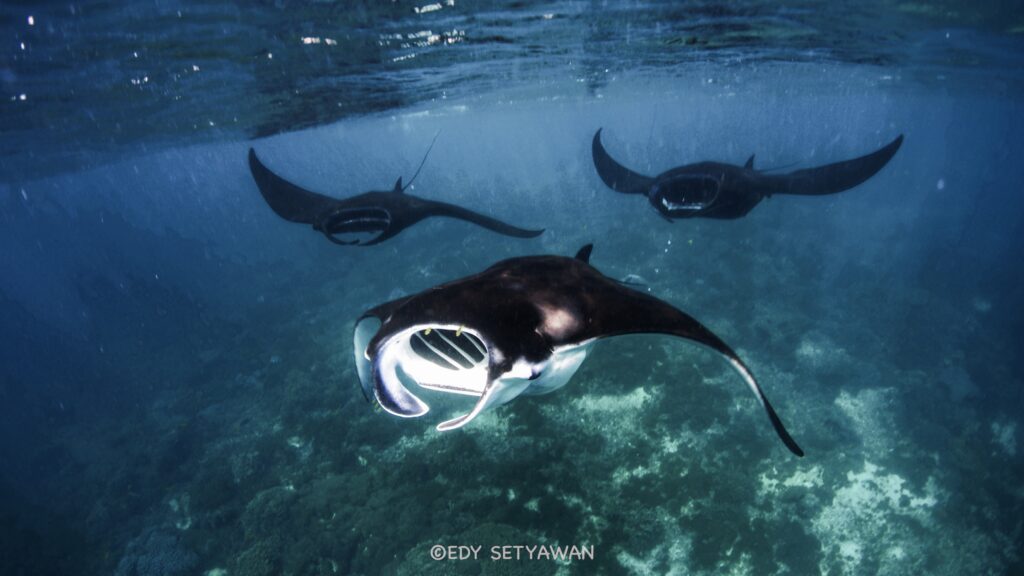Congratulations to Edy Setyawan, our “Manta Man”, on earning his PhD!
Administrator’s note: Some of you may not recognize his name but if you love mantas you have probably read one of his many posts on the BHS site. Dr. Edy Setyawan, from Boyolali, a small town near Mount Merapi in Central Java (Indonesia) is not only the BHS Manta Ray Researcher, but he is now a Marine Ecologist. We want to congratulate Dr. Edy Setyawan who recently received his PhD from the University of Auckland, New Zealand.
About Dr. Edy Setyawan
His doctoral thesis was entitled “Movement Ecology, Population Dynamics, and Conservation of Reef Manta Rays (Mobula alfredi) in Raja Ampat, Indonesia”. Population Dynamics, and Conservation of Reef Manta Rays (Mobula alfredi) in Raja Ampat, Indonesia”. During his PhD, he received a number of awards from University of Auckland. Some of which include the Blues Awards for Innovation in pioneering a novel method for the measuring the body size of manta rays using a small drone. His name was also listed on the Dean of Graduate Studies List (Dean’s List), in recognition of excellence achieved with his PhD thesis. This one of the highest honors that can be achieved at the University of Auckland.
Edy has written over a dozen articles for us (just do a search on the site). But if you first want to know more about him, read his profile.
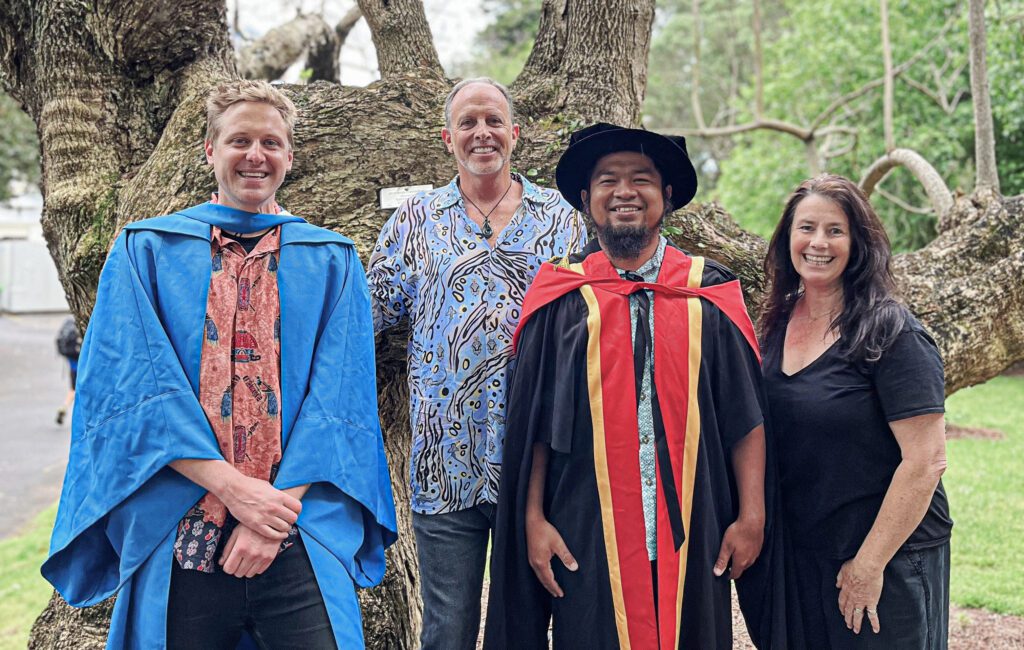
Edy’s PhD supervisors at his post graduation celebration, (l to r), Dr Ben Stevenson, Dr Mark Erdmann, Edy, and Professor Rochelle Constantine.
Edy works with elasmobranchs, which refers to the cartilaginous fishes – sharks, rays and skates. These animals skeletons are made of cartilage not bone. Although his passion and the focus of his PhD work are manta rays, he also works with whale sharks. Since completing PhD, he has started doing research on the Raja Ampat’s epaulette sharks a.k.a. walking sharks. This research focuses on the natural history and population structure of the Raja Ampat epaulette sharks using photographic identification. He is also looking at the residency, fine scale movements, and habitat preference of this endemic species, as well as the potential impact of climate change, especially temperature tolerance of this understudied species.
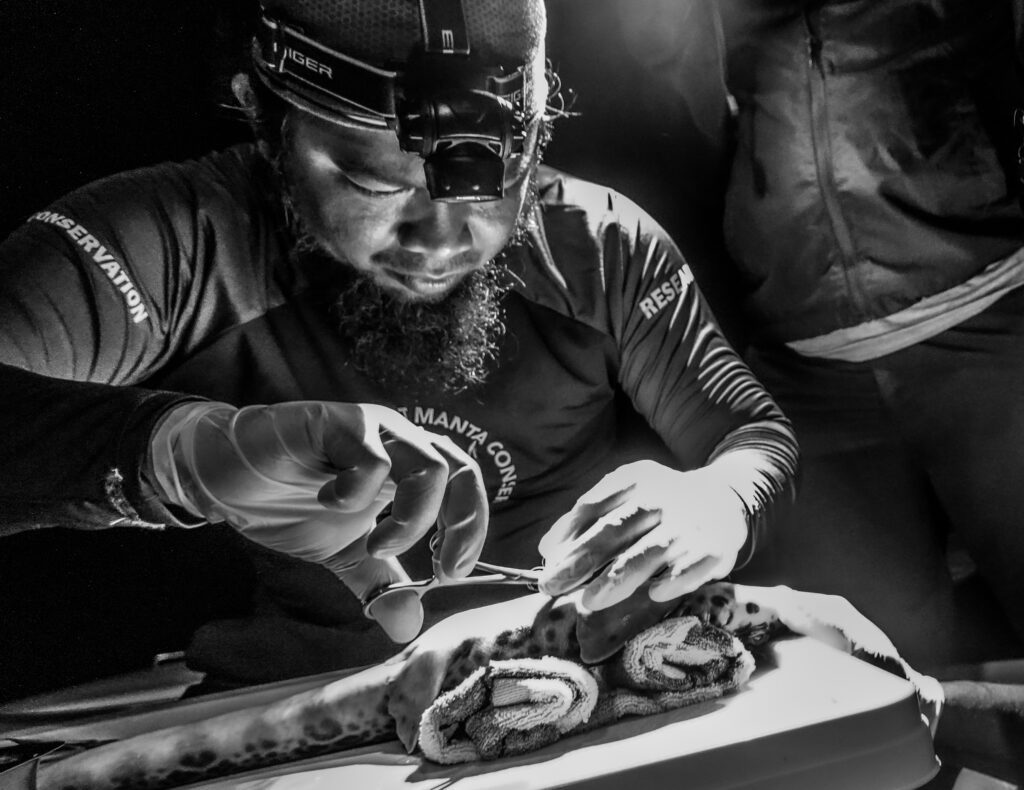
Suturing a walking shark during the surgical procedure to insert an internal acoustic tag © Abdy Hasan
The Bird’s Head Seascape Manta ID Database
Edy is responsible for maintaining the BHS Manta Ray database, which now contains just over 1,900 documented individuals. He would love to see the data base reach the 2000 individuals milestone. But in order to do that he needs your help! When you travel to the BHS and take images of mantas or when reviewing your images from previous trips, be a citizen scientist and send them to him, edysetyawan@gmail.com. Although you can send images directly to Edy it’s better to upload them via the database.
Note: Not just any manta image will do! Did you know the spot pattern on the belly of a manta ray is unique, like a finger print? Edy needs “belly shots”. So when photographing mantas remember and think, “I need to take a belly shot for Edy”. Here are some examples of belly spot pattern images.
In addition to a belly image other essential information like date, time and dive location is needed. All this is clearly explained on the BHS Manta Ray database’s upload page.
Edy is also a keen photographer. His drone images are especially awesome.
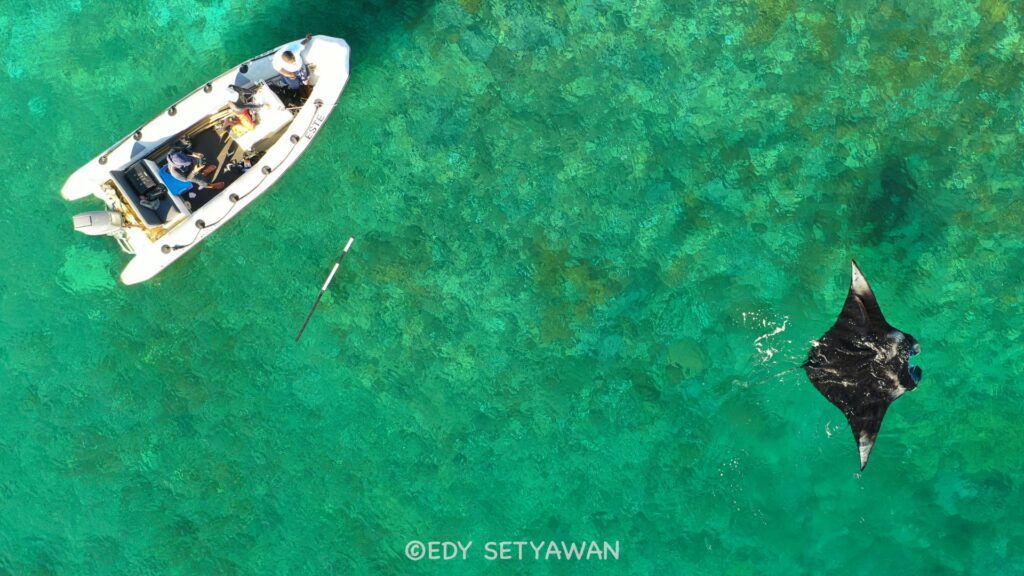
Measuring the body size of a reef manta ray using a drone and a piece of floating pipe of known length. (A novel techniques developed by Edy.) © Edy Setyawan
Featured publications for PhD chapters:
(All can be found on the BHS as well.)
Setyawan et al. (2022). Population estimates of photo-identified individuals using a modified POPAN model reveal that Raja Ampat’s reef manta rays are thriving. Front. Mar. Sci. 9, 1014791. doi: 10.3389/fmars.2022.1014791. On the BHS site, https://birdsheadseascape.com/wpfb-file/setyawan-et-al-2022_manta-population-abundance-estimation-pdf/.
Setyawan et al. (2022). Residency and use of an important nursery habitat, Raja Ampat’s Wayag Lagoon, by juvenile reef manta rays (Mobula alfredi). Front. Mar. Sci. 9. doi: 10.3389/fmars.2022.815094. On the BHS site, https://birdsheadseascape.com/wpfb-file/fmars-09-815094-pdf/
Setyawan et al. (2021). A holistic approach to manta ray conservation in the Papuan Bird’s Head Seascape: Resounding success, ongoing challenges. Mar. Policy 137, 104953. doi: 10.1016/j.marpol.2021.104953. On the BHS, https://birdsheadseascape.com/wpfb-file/setyawan-2022bhsmantarayconservation_2-pdf/.
Setyawan et al. (2022). How big is that manta ray? A novel and non-invasive method for measuring reef manta rays using small drones. Drones 6(3), 63. doi: 10.3390/drones6030063. On the BHS site, https://birdsheadseascape.com/wpfb-file/drones-06-00063-v2_0-pdf/.
Setyawan et al. (2020). Natural history of manta rays in the Bird’s Head Seascape, Indonesia, with an analysis of the demography and spatial ecology of Mobula alfredi (Elasmobranchii: Mobulidae). J. Ocean Sci. Found. 36, 49–83. doi: 10.5281/zenodo.4396260. On the BHS site, https://birdsheadseascape.com/wpfb-file/setyawan-et-al-2020-bhs-manta-rays-pdf/.
While outside his PhD work above, Edy is the author of a series of publications on manta rays in the BHS (search the website for all his publications). One paper, published in 2018, is especially worth reading, Site Fidelity And Movement Patterns Of Reef Manta Rays (Mobula Alfredi: Mobulidae) Using Passive Acoustic Telemetry In Northern Raja Ampat, Indonesia.
Join us in congratulating Edy and send him a present- a belly shot! And look for more research publications and images…coming soon.





































